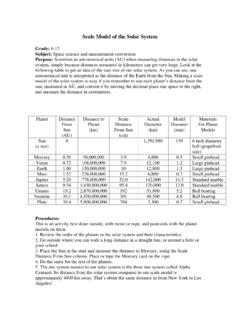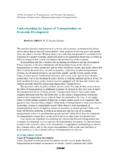Transcription of EXPLORING MARS Bringing Life to Mars - University of New ...
1 EXPLORING MARS. Bringing life to Mars by Christopher P. McKay Climate models suggest that human beings could transform the Red Planet into a more Earth-like world using current technologies F. our billion years ago Mars was a warm and wet planet, possibly teeming with life . Spacecraft orbiting Mars have returned im- ages of canyons and flood valleys features that suggest that liquid water once flowed on the plan- et's surface. Today, however, Mars is a cold, dry, des- ertlike world with a thin atmosphere. In the absence of liquid water the quintessential ingredient for life . no known organism could survive on the Red Planet. More than 20 years ago the Mariner and Viking mis- sions failed to find evidence that life exists on Mars's surface, although all the chemical elements needed for life were present. That result inspired biologists Maurice Averner and Robert D. MacElroy of the National Aero- nautics and Space Administration Ames Research Cen- ter to consider seriously whether Mars's environment could be made hospitable to colonization by Earth- based life -forms.
2 Since then, several scientists, using cli- ALFRED T. KAMAJIAN. mate models and ecological theory, have concluded that the answer is probably yes: With today's technology, we could transform the climate on the planet Mars, making it suitable once more for life . Such an experiment would GREENING OF MARS. is portrayed in this artist's conception of a Martian landscape after the planet has been warmed to Earth-like temperatures. A mobile soil-processing unit (in foreground) generates green- house gases that trap solar energy and trigger the creation of a thick carbon dioxide atmosphere. Plants imported from Earth could grow on the surface, but humans could not breathe the air and would need to carry oxygen tanks. 52 Scientific American Presents Copyright 1999 Scientific American, Inc. allow us to examine, on a grand scale, how biospheres grow the sun, a Martian year is almost twice the length of an Earth and evolve.
3 And it would give us the opportunity to spread year, but plants should be able to adapt to such a difference. One and study life beyond Earth. unalterable difference between Earth and Mars is gravity: Mar- tian gravity is about one third that of Earth's. How life would Why Mars? adapt to reduced gravity is unknown. It is likely, however, that microbes and plants would adjust easily to Martian gravity, and M any of the key physical properties of Mars are remarkably similar to those of Earth [see table on page 54]. On both planets the length of day is about 24 hours an important consid- some animals might cope just as well. Other planets and moons in our solar system also might be considered potential sites for life , including Venus, Titan and Eu- eration for plants that have adapted to photosynthesize when the ropa. Each of these bodies, however, possesses some basic physi- sun shines. Mars also experiences seasons, as the planet's axis is cal parameter that is inconsistent with habitability.
4 Titan and tilted to a similar degree as Earth's. Because Mars is farther from Europa satellites of Saturn and Jupiter, respectively are too far Copyright 1999 Scientific American, Inc. The Future of Space Exploration 53. RED PLANET TURNS BLUE. in this series of images showing how Mars might change if its surface were from the sun. Venus is warmed by human effort. Rising temperatures would release the carbon diox- the freezing point of too close, and its ex- ide and water currently frozen in the planet's polar caps (above). The water water. Adding a bit of tremely dense atmo- would collect primarily in the lowlands of the northern hemisphere, forming a nitrogen to the atmo- sphere makes the plan- large ocean. In the final stage of warming (far right), Mars would have the sphere would help sat- et much too hot for same amount of liquid water that it apparently possessed billions of years ago. isfy the metabolic life .
5 Furthermore, the needs of plants and planet rotates so slow- microbes. And the ly that its day is equal to about four months on Earth, which small amount of oxygen that would be produced from the pho- might make life difficult for plants. The technology needed to tochemical degradation of carbon dioxide could create a rudi- alter these physical parameters is well beyond the current scope mentary but effective ozone shield for the rejuvenated planet. of human capability. This carbon dioxide atmosphere would support plant and mi- Mars is currently too cold, too dry and its carbon dioxide crobial life but would not contain enough oxygen for animals. atmosphere too thin to support life . But these parameters are Although humans would need to carry a supply of breathable interrelated, and all three can be altered by a combination of air with them, a carbon dioxide Mars would still be a much human intervention and biological changes.
6 The key is carbon kinder, gentler place than today's Mars. The higher temperatures dioxide. If we were to envelop Mars in a thicker carbon dioxide and atmospheric pressure would make bulky space suits and atmosphere, with a surface pressure one to two times that of air pressure domes unnecessary. And the natural growth of plants at sea level on Earth, the planet would naturally warm above would allow the cultivation of farms and forests on Mars's sur- face, thus providing food for human colonists or visitors. To make Mars suitable for animals and humans, its atmo- Comparing Earth, sphere would have to be made more similar to Earth's, which is composed primarily of nitrogen, with oxygen levels close to 20. Mars and Venus NASA. percent and carbon dioxide levels less than 1 percent. The pro- cess of generating such an Earth-like, oxygen-rich environment . EARTH MARS VENUS also called terraforming would be much more difficult than Gravity (g's) 1 simply thickening Mars's atmosphere.
7 But to make Mars habit- Length of day 24 hours 24 hours 117 days able, generating a carbon dioxide atmosphere a process that 37 minutes biologist Robert Haynes of York University has dubbed Length of year 365 days 687 days 225 days ecopoiesis would be the logical first step. Axis tilt (degrees) Does Mars possess the essential volatiles carbon dioxide, Average sunlight nitrogen and water needed to create a habitable environment? reaching the planet 345 147 655 Ferrying these raw materials from Earth would be impractical. (watts per square meter) For example, the amount of nitrogen needed to create a breath- Average surface able atmosphere on Mars is more than a million billion tons. temperature 15 60 460 The space shuttle can carry only about 25 tons into low-Earth CHRISTOPHER P. MC KAY. (degrees Celsius). orbit. Thus, if Mars does not have the necessary amount of ni- Surface pressure 1 95. (atmospheres).
8 Trogen, it is not within near-term capabilities of humans to bring it there. Most abundant gases Nitrogen, Carbon Carbon in atmosphere oxygen dioxide dioxide Unfortunately, we do not yet know how much of each of these key ingredients Mars has hidden below its surface. We do know 54 Scientific American Presents EXPLORING Mars Copyright 1999 Scientific American, Inc. MICHAEL CARROLL. that the thin Martian atmosphere currently contains only small the size of the state of Texas to increase the amount of sunlight amounts of carbon dioxide, nitrogen and water vapor. But at one hitting Mars by just 2 percent. time Mars must have had a much thicker atmosphere. Research- Perhaps the most practical approach to warming Mars ers have used a variety of methods to estimate how much carbon would involve using super-greenhouse gases to trap solar en- dioxide, nitrogen and water would have been present in the early ergy on the planet.
9 This method was first suggested by British Martian atmosphere. These methods which include measuring atmospheric scientist James Lovelock, who is best known for the ratio of nitrogen isotopes and estimating the volume of water the Gaia hypothesis that the presence of life maintains the hab- needed to etch the Martian flood channels yield widely different itability of Earth. Lovelock's idea for heating Mars involved estimates of the amount of volatiles once present on the planet. pumping gases such as methane, nitrous oxide, ammonia and Fortunately, the range of estimates overlaps the amounts of perfluorocarbons (PFCs) into the Martian atmosphere. These volatiles needed to produce a breathable atmosphere and a sub- super-greenhouse gases can trap solar energy with thousands of stantial ocean [see table below]. It is possible that some of these times the efficiency of carbon dioxide, the most abundant volatiles have left the planet permanently, flowing out into space greenhouse gas on Mars and Earth.
10 Even small amounts of the because of Mars's low gravity. If, however, Mars once had super-greenhouse gases can warm a planet; in fact, many scien- enough of the volatiles needed to make a biosphere, it probably tists believe that the production of these gases is contributing to still has them locked up in the subsurface. Water could be frozen global warming here on Earth. as ground ice, and nitrogen could be contained in nitrates in the Computer calculations performed by myself, Owen B. Martian soil. Carbon dioxide could be frozen in Mars's polar Toon and James F. Kasting suggest that if Mars's atmosphere caps as well as in the soil. contained just a few parts per million of the super-greenhouse gases, the average temperature at the planet's surface would Turning up the Heat I f Mars does have the essential ingredients, the first step in transforming the environment is to warm the planet. Heating the Martian surface would release the carbon dioxide, nitrogen The Essential Ingredients for life on Mars Carbon dioxide Nitrogen Water surface surface ocean and water vapor into the atmosphere.






